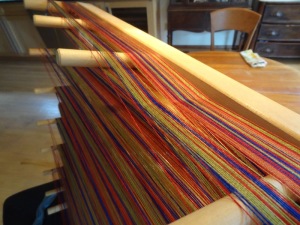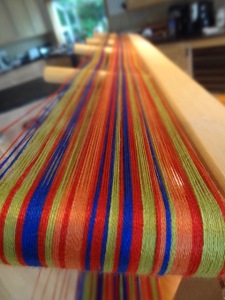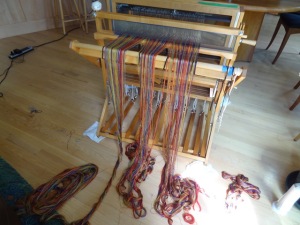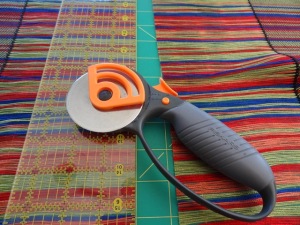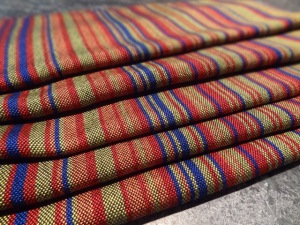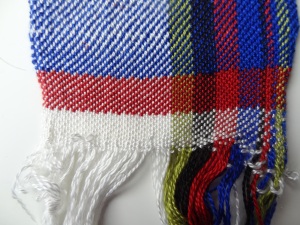 It turns out that the problematic gene is Chromosome 18, so Jay sent me the first three pages of the detailed readout for C18, which was 143 bases. By using 3 ends per base, this would make for a scarf with a nice width. I noticed that the color coding on the readout was different in one respect from the one I had been using; orange instead of black for guanine. Since the black had been standing out a bit too much, I decided to make that switch. Here’s the final sample, using orange, blue, green, and red, with black as the weft. Jay was visiting Seattle just after I finished it, and he enjoyed being able to see and hold the little piece of fabric. With a good result from the final sample, I plunged into winding the warp for the actual scarves.
It turns out that the problematic gene is Chromosome 18, so Jay sent me the first three pages of the detailed readout for C18, which was 143 bases. By using 3 ends per base, this would make for a scarf with a nice width. I noticed that the color coding on the readout was different in one respect from the one I had been using; orange instead of black for guanine. Since the black had been standing out a bit too much, I decided to make that switch. Here’s the final sample, using orange, blue, green, and red, with black as the weft. Jay was visiting Seattle just after I finished it, and he enjoyed being able to see and hold the little piece of fabric. With a good result from the final sample, I plunged into winding the warp for the actual scarves.
(click photos to embiggen)
A tool called a warping board is used to measure the threads of a warp and keep them organized before they are put into the loom.
By making a cross of threads going up over a peg in one direction and under the same peg as the thread is wound in the other direction, the exact order of threads is preserved. This not only helps prevent tangles, but with complex stripes like this warp has, it keeps everything in precise order.
Here’s one section of the warp completed. It was wide enough that I did it in three sections.
All three sections with the associated parts of the genome readout.
Here’s one warp section with the readout page it is duplicating.
Next step, putting it on the loom!
At this point, all three sections are on the loom and through the reed and heddles. The warp is being wound onto the warp beam in the back. I gently comb out any tangles and wind the yarn onto the back beam by using the crank handle you can see on the right.
I decided to hemstitch each end of the scarves – an elegant touch that I felt the project deserved.
Here’s the first scarf finished, and off the loom. The ends are twisted into fringe, and this picture shows part of the scarf with the corresponding genome printout, starting at the beginning of Chromosome 18. Interestingly, the sequencing only shows one half of the genetic makeup. C only bonds with G and A only bonds with T. On the readout, you’ll often see more than one of the same letter in a row – this doesn’t indicate that, say, A has bonded
with A across the chromosome, but that two base pairs of A and T are next to each other. The scarf reflects only the half of the data that is represented on the readout. To read the scarf from the beginning of Chromosome 18, align it so that the side with wider green stripes is to the left.
Since Jay was visiting Seattle again a week after I showed him the final sample, I got into high gear to finish the first scarf in time to present it to him in person.
He liked, he really liked it!
With the first scarf off the loom and delivered to Jay, I plunged into weaving the additional five that were warped up. The actual weaving only took about 90 minutes per scarf, plus roughly another 90 minutes to hemstitch both ends. Fringe twisting added another 90 minutes, and it took a bit more time to wash and press them.
Here the scarves are all off the loom and I’m cutting apart the unwoven warp between scarves that gets turned into the fringe. A rotary cutter is the perfect tool for this. You can see the hemstitching that marks the end of one scarf and the beginning of the next.
Miles of twisted fringe! I would probably still be making twisted fringe had Syne Mitchell not kindly lent me her electric fringe twister.
Done.
This project has been a privilege to work on. The work is intended to be a manifestation of respect, admiration, and love, based on a small part of the genetic code that created a remarkable person, Jay Lake. The recipients of the additional scarves are people who have helped him in his time of need, and I honor their gifts of time, energy, and support to him with my own.


